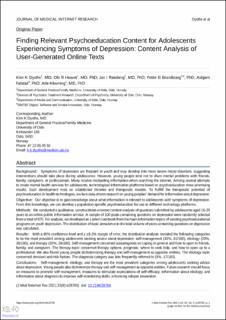| dc.description.abstract | Background:
Symptoms of depression are frequent in youth and may develop into more severe mood disorders, suggesting interventions should take place during adolescence. However, young people tend not to share mental problems with friends, family, caregivers, or professionals. Many receive misleading information when searching the internet. Among several attempts to create mental health services for adolescents, technological information platforms based on psychoeducation show promising results. Such development rests on established theories and therapeutic models. To fulfill the therapeutic potential of psychoeducation in health technologies, we lack data-driven research on young peoples’ demand for information about depression.
Objective:
Our objective is to gain knowledge about what information is relevant to adolescents with symptoms of depression. From this knowledge, we can develop a population-specific psychoeducation for use in different technology platforms.
Methods:
We conducted a qualitative, constructivist-oriented content analysis of questions submitted by adolescents aged 16-20 years to an online public information service. A sample of 100 posts containing questions on depression were randomly selected from a total of 870. For analysis, we developed an a priori codebook from the main information topics of existing psychoeducational programs on youth depression. The distribution of topic prevalence in the total volume of posts containing questions on depression was calculated.
Results:
With a 95% confidence level and a ±9.2% margin of error, the distribution analysis revealed the following categories to be the most prevalent among adolescents seeking advice about depression: self-management (33%, 61/180), etiology (20%, 36/180), and therapy (20%, 36/180). Self-management concerned subcategories on coping in general and how to open to friends, family, and caregivers. The therapy topic concerned therapy options, prognosis, where to seek help, and how to open up to a professional. We also found young people dichotomizing therapy and self-management as opposite entities. The etiology topic concerned stressors and risk factors. The diagnosis category was less frequently referred to (9%, 17/180).
Conclusions:
Self-management, etiology, and therapy are the most prevalent categories among adolescents seeking advice about depression. Young people also dichotomize therapy and self-management as opposite entities. Future research should focus on measures to promote self-management, measures to stimulate expectations of self-efficacy, information about etiology, and information about diagnosis to improve self-monitoring skills, enhancing relapse prevention. | en_US |

